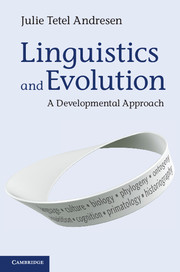Book contents
- Frontmatter
- Contents
- List of Figures
- Introduction Historiography’s contribution to theoretical linguistics
- Part I Theoretical considerations
- Part II A developmental systems linguistics
- 4 Evolutionary scenarios I: the standard story and the self-reproductionist script
- 5 Evolutionary scenarios II: the emerging story and the self-realizationist script
- 6 The ontogenic script begins
- 7 The ontogenic script continues
- Part III What to do next
- Bibliography
- Name index
- Subject index
5 - Evolutionary scenarios II: the emerging story and the self-realizationist script
Published online by Cambridge University Press: 05 June 2014
- Frontmatter
- Contents
- List of Figures
- Introduction Historiography’s contribution to theoretical linguistics
- Part I Theoretical considerations
- Part II A developmental systems linguistics
- 4 Evolutionary scenarios I: the standard story and the self-reproductionist script
- 5 Evolutionary scenarios II: the emerging story and the self-realizationist script
- 6 The ontogenic script begins
- 7 The ontogenic script continues
- Part III What to do next
- Bibliography
- Name index
- Subject index
Summary
The story to be told in this chapter is emerging in two senses: it is gaining acceptance as an explanatory framework, and it suggests that the human languaging network is a phenomenon that emerged over several million years to become recognizably modern in the last several hundred thousand years. Although this seems like a fairly straightforward statement to make, nothing about this topic is straightforward. The editors of Language Evolution, Morten Christiansen and Simon Kirby, are well aware of that fact when they ask the deliberately provocative question: “Language Evolution – the hardest question in science?” Of course, they realize that it is unanswerable, since every discipline has its difficult questions, and they concede that those studying consciousness have already “laid claim to the phrase ‘the hard problem.’” Nevertheless, they consider the problem of language evolution to be a unique scientific challenge, given that language, being difficult enough to define to begin with, is also “by far the most complex behaviour we know of” (2003: 15). As such, it requires examination from an extremely wide variety of disciplines.
Certainly this is true. However, the difficulty of the problem does not derive solely from the complexity of the behavior or the variety of disciplines involved in tackling it – though these aspects of the undertaking surely do pose distinct challenges. Rather, the difficulty of the problem lies in the fact that the question of the evolution of language – or, rather, the question of the instantiation, development and maintenance of the human languaging network – has some of the most historically embedded conceptual baggage to unpack before one can move forward.
- Type
- Chapter
- Information
- Linguistics and EvolutionA Developmental Approach, pp. 132 - 164Publisher: Cambridge University PressPrint publication year: 2013

